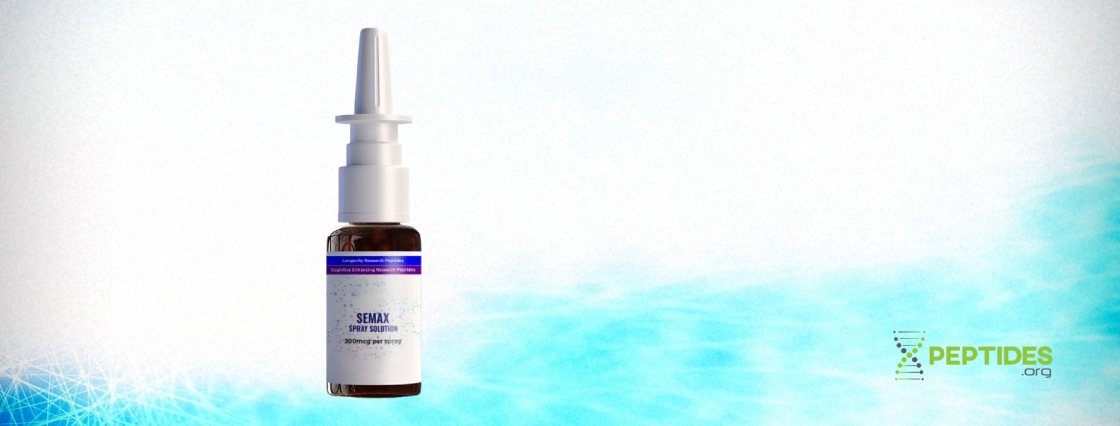Curious about Semax benefits? Then this is the right place.
In this comprehensive review, we break down what researchers must know about Semax's benefits and why it is quickly becoming one of the most studied nootropics in the world.
We also answer important questions, including:
- Is Semax effective for cognitiоn and neurological disorders?
- How does Semax stack up against other nootropics?
- How can Semax benefits be maximized in research settings?
Keep reading to discover what the latest research studies say about the benefits of Semax, including its effects on mood, cognition, and neuroprotection.
We will also share information on our most trusted vendors for both Semax nasal spray and subcutaneous Semax.
Buy Semax Nasal Spray from our top-rated vendor...

Disclaimer: Peptides.org contains information about products that are intended for laboratory and research use only, unless otherwise explicitly stated. This information, including any referenced scientific or clinical research, is made available for educational purposes only. Likewise, any published information relative to the dosing and administration of reference materials is made available strictly for reference and shall not be construed to encourage the self-administration or any human use of said reference materials. Peptides.org makes every effort to ensure that any information it shares complies with national and international standards for clinical trial information and is committed to the timely disclosure of the design and results of all interventional clinical studies for innovative treatments publicly available or that may be made available. However, research is not considered conclusive. Peptides.org makes no claims that any products referenced can cure, treat or prevent any conditions, including any conditions referenced on its website or in print materials.
What is Semax?
Semax, or ACTH(4-7)Pro-Gly-Pro, is a research peptide that appears to offer powerful therapeutic benefits for individuals suffering from neurological diseases [1].
Soviet researchers originally developed the Semax peptide structure in the 1980s and designed it to actively pass through the blood-brain barrier (BBB) [2, 3, 4].
They incorporated four amino acids (Met-Glu-His-Phe) from adrenocorticotropic hormone (ACTH) as Semax's N-terminus and the Pro-Gly-Pro fragment as its C-terminus [5].
As a result, the peptide is devoid of any ACTH-like effects but passes the BBB and appears to carry potential for a wide range of therapeutic benefits [6].
Currently, the peptide is officially approved for therapy in Russia and Ukraine for several indications such as dementia, stroke, general cognitive decline, optic nerve atrophy, and encephalopathy [7].
It is available for researchers in both subcutaneous and nasal spray format. Preliminary research shows that both formulations have sufficient bioavailability in the central nervous system to exert nootropic and neuroprotective effects [4, 8].
Semax can also be modified via acetylation at its N-terminus and amidation at its C-terminus, which results in the N-Acetyl Semax Amidate formulation. This modified version is purported to have better stability compared to its unmodified counterpart [9].

How Does Semax Work?
Semax is thought to work by passing through the BBB, where it interacts with neurotransmitters and molecules called neurotrophins. These are growth factors that regulate the survival, development, and function of neurons in both the central and peripheral nervous systems [3, 10].
More specifically, Semax appears to upregulate Brain-Derived Neurotrophic Factor (BDNF) and Nerve Growth Factor (NGF). The peptide also appears to upregulate the expression of tropomyosin-related kinase B (trkB) receptors, which mediate the effects of BDNF [3, 10].
According to one experiment, Semax was capable of significantly boosting BDNF levels by 60% and increasing trkB expression by 100% (2-fold) [11]. Activating BDNF and NGF is thought to exert neuroprotective effects, reduce inflammation, and increase the tolerance of neurons toward hypoxia [3].
As mentioned, the peptide may also interact with neurotransmitters and their respective signaling systems. Studies report that Semax may interact with serotonin and dopamine signaling, which are well-known to play a role in mood, desire, and cognition [12].
A separate trial suggests that Semax may inhibit the breakdown of enkephalins in the central nervous system, which are the physiological ligands of opioid receptors. As a result, the peptide may help regulate pain perception and reward-driven behavior [13, 14].
Semax may also exert benefits outside the nervous system, even when applied intranasally. Researchers report anti-ulcer effects, which are posited to occur due to Semax's benefits on blood flow, microcirculation, and vascular permeability [15].
Top 5 Benefits of Semax
Semax is a unique nootropic and neuroprotective peptide with the ability to regulate neurotransmitter production and increase neuroplasticity in the brain.
Below, we will cover five noteworthy potential benefits of Semax and their supporting data.
Semax for Cognition and Memory Enhancement
Clinical studies report that the peptide may exert potent nootropic effects and may act as a stimulant in fatigued study volunteers [16].
Resting-state functional magnetic resonance imaging (resting-state fMRI) has also shown that the peptide may increase the volume of certain parts of the central nervous system, such as the medial frontal cortex, which is involved in reward, affective, and decision-making processes [17].
Researchers have also posited that Semax may have benefits for attention deficit hyperactivity disorder (ADHD), although studies are yet to investigate such claims [6].
Semax and Neuroprotection
Some of the most notable neuroprotective effects of Semax have been observed in stroke patients. Scientists report anti-inflammatory, radioprotective, anti-hypoxic, and neurotrophic activity in acute conditions such as ischemic stroke [18, 19].
Semax may also protect the optic nerve from damage in patients suffering from increased intraocular pressure (glaucoma) [20, 21].
Limited clinical trials also suggest protective effects against chronic ischemia and neurotoxins such as alcohol [22, 23]. In vitro and in vivo test animal trials hypothesize that the peptide may also provide protective effects in models of Parkinson's and Alzheimer's dementia [24, 25].
Semax for Mood Regulation
Preliminary studies in rats have suggested that the peptide may provide antidepressant and anxiolytic effects. Researchers hypothesized that this may be due to its interactions with serotonergic signaling and BDNF expression [26].
One clinical study also reported that Semax may benefit the emotional state of patients with motor neuron disease (MND) [27]. However, more trials are needed to confirm these benefits in clinical settings.
Semax for Stress Reduction
Rat studies have shown that Semax may protect against anxiogenic substances such as cholecystokinin-tetrapeptide (CCK-4). This substance is also known to cause anxiety in humans, and it's commonly employed to test anxiolytic drugs [28].
The peptide has also been reported to reduce stress indicators in rats exposed to acute restraint stress (ARS) [29]. Nevertheless, more research is needed to evaluate the peptide’s purported anti-stress properties.
Semax for Ulcer Healing
Clinical data also suggest that the Semax may exert anti-ulcer effects in test subjects suffering from refractory peptic ulcers. Yet, more clinical trials are needed to confirm its potential to this end [15].
Semax Benefits | Scientific Studies and Research
Semax is recognized for its clinically-backed benefits in neurological disease patients. Research shows it may also be effective in improving overall cognitive function and performance in otherwise healthy adults.
Here is an overview of what the latest research studies say about Semax.
Overview of Semax Studies
It is important to note that the available evidence on Semax's benefits as a nootropic, neuroprotective agent, and mood regulator is limited to trials conducted in Russia and Post-Soviet states [2].
The peptide has not been evaluated or approved by any regulatory bodies in Western Europe or the United States. Some clinical trials are also limited in their strength and lack placebo controls for objective comparison [18].
Nevertheless, preliminary human studies suggest that the peptide may have neuroprotective and nootropic benefits. All clinical trials have employed the intranasal route to administer the peptide [16, 17, 18, 19, 20, 21, 22, 23].
On the other hand, subcutaneous Semax has been studied only in preclinical settings, where the peptide appears to exert similar properties [3, 12, 29, 30]. Benefits such as stress reduction, antidepressant, and anxiolytic effects are also limited to rat studies.
Cognitive Enhancement Research
One of the most notable clinical studies reporting on the nootropic effects of Semax included 16 healthy male volunteers (ages 20-40) who were fatigued after an 8-hour work shift [16].
A single administration of intranasal Semax at a dose of 1mg (about 16mcg/kg of body weight) resulted in a 71% memory test accuracy vs. an average of 41% observed in controls. The researchers reported that these benefits were sustained through the next day and lasted for up to 24 hours [16].
In another study, researchers examined the impact of Semax on the default mode network (DMN) in the brains of 24 middle-aged individuals. The DMN consists of brain structures responsible for processing emotional and environmental information, episodic memory, and social interactions [17].
During the study, participants underwent resting-state functional magnetic resonance imaging (fMRI) on three occasions: before receiving treatment, and 5 and 20 minutes after intranasal administration of either a 1% Semax solution or placebo. Among the participants, 10 received placebo [17].
The Semax group experienced increased volume in the rostral subcomponent of the DMN, specifically within the medial frontal cortex, in comparison to the control group. The authors suggested that Semax may offer potential benefits for functions associated with information processing and episodic memory [17].
Neuroprotection Research
Researchers have also focused on investigating the potential neuroprotective properties of Semax, particularly in individuals who have suffered from brain ischemia and stroke.
For example, a study involving acute stroke patients demonstrated that Semax has notable anti-inflammatory effects. Semax prompted an increase in the presence of anti-inflammatory agents like interleukin-10 (IL-10) and tumor necrosis factor-alpha (TNF-alpha) while reducing levels of proinflammatory factors such as interleukin-8 (IL-8) and C-reactive protein (CRP) [18].
Another study examined the effects of Semax on 110 stroke patients. The peptide was administered intranasally in two 10-day courses, each consisting of 6000 mcg/day Semax, with a 20-day wash-out period in between [19].
The patients were divided into two rehabilitation groups: early rehabilitation (with an average time since the stroke of 89±9 days) and late rehabilitation (with an average time since the stroke of 214±22 days). These groups were further divided into subgroups, some receiving Semax and others placebo [19].
Semax resulted in increased levels of plasma BDNF (brain-derived neurotrophic factor), which in turn led to improved motor performance and enhanced scores on the Barthel index—an assessment tool for measuring functional independence in stroke patients [19].
As mentioned, the peptide has also demonstrated neuroprotective effects in clinical trials of chronic ischemia, optic nerve damage, and alcohol intoxication [20, 21, 22, 23].
Mood Regulation Research
No clinical studies thus far have aimed to directly assess the effects of Semax on mood. Yet, in a study involving 27 patients with motor neuron disease (MND), researchers investigated the effects of Semax on muscle activity at different sections of the body [27].
Semax was administered intranasally as a 1% solution in two ten-day courses with a two-week break at a daily dose of 12mg. In addition, the patients were assessed using various scales to measure their quality of life and disease progression [27].
The study found that Semax did not affect disease progression or clinical measures related to functional deficits. However, it significantly improved the overall quality of life, primarily due to improvements in emotional state and motivation [27].
Nevertheless, the research regarding Semax's effects on mood is scarce, and more evidence is needed to confirm its benefits.
Stress Reduction Research
Currently, no clinical trials have investigated the peptide’s effect on stress. Nevertheless, rat studies suggest that the peptide may possess benefits against stress and anxiety [29].
In a laboratory animal study, rats were tested both under normal conditions and when exposed to the stress-inducing agent CCK-4. Semax was administered intranasally at doses of 50 and 500 mcg/kg. The peptide did not affect the emotional state of rats under normal conditions [28].
However, when rats were exposed to CCK-4, which increased anxiety and depression levels, Semax administration prior to CCK-4 normalized the disrupted behavior, suggesting that Semax may have anxiolytic and antidepressant effects, specifically when anxiety and depression levels are elevated [28].
How To Maximize Semax Benefits
To maximize Semax benefits, researchers must take into account key factors including employing optimized dosing protocols and selecting the most appropriate administration method.
To begin with, researchers should choose between Semax nasal spray and subcutaneous Semax to select the more appropriate administration method depending on test subject tolerance and compliance.
Dosage is another major factor that may impact the magnitude of Semax benefits. Available clinical studies have employed intranasal Semax in doses between 600mcg/daily to 12000mcg/daily [22, 27].
Study durations have varied from up to 30 days of daily Semax administration to Semax cycling, which involves 10 days of application followed by 14 days’ rest, and then another 10 days of application [21, 27].
Unfortunately, no studies examine the potential dosage of injectable Semax in clinical settings. Therefore, scientists and qualified professionals should prioritize safety and consider implementing a dosing regimen of 1000mcg or less per day in their Semax injections research.
Based on the aforementioned considerations, researchers may consider a subcutaneous dosage range of Semax between 500mcg/daily for up to 60 days or 1000mcg/daily for up to 30 days.
Following the experiment, it is crucial to ensure an equivalent rest period matching the study duration. Throughout the study, it is essential to monitor the subjects' neurological, psychological, and physical status, as well as their EEG signals.
Additionally, the potential combination of Semax with other nootropic drugs and supplements should be considered, as well as the influence of lifestyle factors on the outcomes in test subjects.
For improved results, researchers may consider combining Semax with certain nootropics:
- Naturally-occuring nootropics: Bacopa monnieri, lion's mane mushroom, and ginkgo biloba.
- Cholinergic agents: Alpha-GPC, citicoline (CDP-choline), and centrophenoxine.
- Racetams: Piracetam, aniracetam, and oxiracetam.
- Stimulants: Modafinil, adrafinil, and armodafinil.
Further caution must be exercised when combining Semax with other nootropics, as Semax itself is considered a mild stimulant, which could increase the risk of side effects in test subjects.
Researchers are encouraged to assist test subjects in optimizing their overall lifestyle while undergoing Semax trials. Certain lifestyle changes can help maximize the therapeutic benefits of Semax, including practicing stress-reduction techniques, getting sufficient and high-quality sleep, staying adequately hydrated by consuming plenty of water, and following a healthy, balanced diet.
By optimizing dosing protocols, combining Semax with appropriate nootropics, and improving the lifestyle factors of test subjects, researchers can maximize the therapeutic benefits of Semax, thereby enhancing study outcomes.

Where to Buy Semax Online? | 2024 Edition
Qualified peptide researchers can legally purchase Semax online as a reference material.
To ensure the purity of research peptides such as Semax, our expert panel recommends buying strictly from vendors who use accredited facilities in the United States and subject their peptides to third-party laboratory testing for purity.
Here are our top recommendations for superior Semax products.
Limitless Life
Limitless Life is our go-to source for peptide-based nasal sprays.
Here is why this vendor stands out:
- High-Purity Peptides: All Limitless Life peptides, including Semax nasal spray, undergo rigorous analysis using high-performance liquid chromatography and mass spectrometry (HPLC-MS) testing to ensure purity levels exceeding 98%.
- USA-Made Semax: Limitless Life sources their high-quality Semax nasal spray formulations from fully accredited manufacturers in the United States.
- Quick and Free Shipping: Limitless Life provides free shipping for orders of $350+ within the United States and guarantees quick delivery, with most orders processed the same day as they are placed.
Overall, we highly recommend Limitless Life as an exceptional vendor of intranasal peptides, including Semax.
Buy Semax Nasal Spray from our top-rated vendor...

PureRawz
PureRawz is another top vendor that offers lyophilized Semax powder in aliquot form.
Here’s why research can rest easy when ordering from this company:
- Research-Grade Semax: PureRawz ships Semax that is thoroughly tested both in-house and at a third-party laboratory, ensuring that all batches are genuine and safe to administer.
- Efficient Shipping: The company offers a variety of shipping options to research around the globe, and orders over $100 even ship free.
- Rapid Support: The company offers fast support via live chat, phone, and email. They strive to ensure that each and every researcher is satisfied, regardless of the issue.
Buy research peptides from Pure Rawz today...

Benefits of Semax | Verdict
Semax is one of the more promising research peptides due to its nootropic and neuroprotective effects.
Based on current preclinical and clinical data, Semax may offer benefits including enhanced neuroplasticity, neuro-regeneration, improved memory, enhanced concentration, and superior protection of nerve cells against hypoxia and oxidative stress.
Researchers should fully evaluate both the intranasal and subcutaneous methods to improve the benefits of Semax, in addition to selecting an appropriate dosage prior to administering the peptide in their own research studies.

